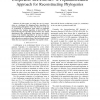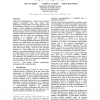77 search results - page 2 / 16 » Reconstructing Phylogenetic Networks Using Maximum Parsimony |
EVOW
2009
Springer
13 years 11 months ago
2009
Springer
The Maximum Parsimony problem aims at reconstructing a phylogenetic tree from DNA, RNA or protein sequences while minimizing the number of evolutionary changes. Much work has been ...
CIBCB
2005
IEEE
13 years 10 months ago
2005
IEEE
Abstract— In this paper, we study the use of cooperation as a technique for designing faster algorithms for reconstructing phylogenetic trees. Our focus is on the use of cooperat...
ICNC
2005
Springer
13 years 9 months ago
2005
Springer
Abstract. Four local search algorithms are investigated for the phylogenetic tree reconstruction problem under the Maximum Parsimony criterion. A new subtree swapping neighborhood ...
APBC
2004
13 years 5 months ago
2004
Undiscovered relationships in a data set may confound analyses, particularly those that assume data independence. Such problems occur when characters used for phylogenetic analyse...
GECCO
2006
Springer
13 years 8 months ago
2006
Springer
The most popular approaches for reconstructing phylogenetic trees attempt to solve NP-hard optimization criteria such as maximum parsimony (MP). Currently, the bestperforming heur...


